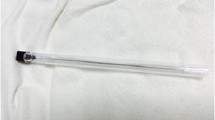Summary
Nine new cases of prenatally detected true mosaic trisomy 20 (T20) are reported. In three instances the fetuses were aborted. One fetus showed multiple malformations associated with a high percentage of T20 cells among amniotic fluid (AF) cells and fibroblasts of different fetal tissues. In two other fetuses only a slight facial dysmorphy was seen which was accompanied by a low percentage of T20 cells among AF cells. In five instances the pregnancies were carried to term, and normal somatic and psychomotor development of the children has been observed, in one case up to the age of 24 months. In one case the pregnancy is continuing. The T20 cells were not detected among cultured lymphocytes of these children.
A review of the hitherto known cases of prenatally detected mosaic T20 indicates a relationship between the prenatal findings and the fetal development. This may serve as a provisory basis for genetic counselling: in the case of a percentage above 50% of T20 cells among AF cells there seems to be a risk of about 50% for the fetus to be affected by severe anomalies. However, in cases of a prenatally detected mosaic T20 with a percentage equal to or less than 50, fetal or congenital malformations have not been observed among 23 individuals so far examined.
Similar content being viewed by others
References
Bosze P, Laszlo J, Toth A (1982) Trisomy 20 mosaicism in amniotic fluid cells. Prenatal Diagn 2:225–227
Boué J, Nicolas H, Barichard F, Boué A (1979) Le clonage des cellules du liquide amniotique, aide dans l'interpretation des mosaiques chromosomiques en diagnostic prenatal. Ann Genet (Paris) 22:3–9
Carbonell X, Caballin MR, Rubio A, Egozcue J (1977) Trisomy 20 mosaicism. Acta Paediatr Scand 66:787–788
Creasy MR, Crolla JA, Alberman ED (1976) A cytogenetic study of human spontaneous abortions using banding techniques. Hum Genet 31:177–196
Golbus MS, Loughman WD, Epstein CJ, Halbasch G, Stephens JD, Hall BD (1979) Prenatal genetic diagnosis in 3000 amniocenteses. N Engl J Med 300:157–163
Hsu LYF, Kim H, Hausknecht R, Hirschhorn K (1976) Prenatal diagnosis of 45,X/46,XY mosaicism with postnatal confirmation in a phenotypically normal male infant. Clin Genet 10:232–238
Hsu LYF, Yahr F, Kim HJ, Kerenyi T, Hirschhorn K (1978) Five hundred and fifty cases of prenatal cytogenetic diagnosis: experience and prospects. Mt Sinai Med (NY) 45:135–149
Jacobs PA, Melville M, Ratcliffe S, Keag AJ, Syme J (1974) A cytogenetic survey of 11,680 newborn infants. Ann Hum Genet 37:359–376
Kajii T, Ferrier A, Niikawa N, Takahara H, Ohama K, Avirachan S (1980) Anatomic and chromosomal anomalies in 639 spontaneous abortuses. Hum Genet 55:87–98
Kardon NB, Lieber E, Davies JG, Hsu LYF (1979) Prenatal diagnosis of trisomy 20 mosaicism. Clin Genet 15:267–272
Laurence KM, Gregory P (1976) Prenatal diagnosis of chromosome disorders. Br Med Bull 32:9–15
Mascarello JT, Chadwick DL, Moyers TG (1980) Trisomy 20 mosaicism in amniotic fluid cells. Lancet i:1089
McDermott A, Gardner A, Ray B (1981) Trisomy 20 mosaicism in a foetus. Prenatal Diagn 1:147–151
Nevin NC, Nevin J, Thompson W (1979) Trisomy 20 mosaicism in amniotic fluid cell culture. Clin Genet 15:440–443
Nisani R, Rappaport S, Felsenburg T, Chemke I (1981) Trisomy 20 mosaicism in amniotic cell cultures. Poster session 19-16, Abstracts of the 6th international congress of Human Genetics, Jerusalem Israel; cited by Hsu LYF, Perlis TE (1984) United States survey on chromosome mosaicism and pseudomosaicism. Prenatal Diagn 4:97–130
Rodriguez ML, Luthy D, Hall JG, Norwood TH, Hoehn H (1978) Amniotic fluid cell mosaicism for presumptive trisomy 20. Clin Genet 13:164–168
Rudd NL, Gardner HA, Worton RG (1977) Mosaicism in amniotic fluid cell cultures. Birth Defects XIII:249–258
Schwinger E, Rehder H (1981) Prenatal trisomy 20 mosaicism: origin in fetal kidney cells? Lancet ii:1111
Steinbach P, Djalali M, Rolland MO (1985) Prenatal diagnosis of a true mosaic trisomy 20 substantiated by demonstration of a gene dosage effect for adenosine deaminase (ADA). Prenatal Diagn
Wahlström J, Borgsgard J, Sabel KG (1976) A case of trisomy 20? Clin Genet 9:187–191
Watt JL, Couzin DA, Johnston AW, Jandial V, Gray ES (1981) Prenatal detection of Turner's syndrome in conjunction with trisomy 20 mosaicism (45,X/46,X,+20). J Med Genet 18:225–241
Weise W, Quent P (1980) Bedeutung des Trisomie-20-Mosaizismus in der pränatalen Diagnostik. Zentralbl Gynäkol 102:770–773
Author information
Authors and Affiliations
Rights and permissions
About this article
Cite this article
Djalali, M., Steinbach, P., Schwinger, E. et al. On the significance of true trisomy 20 mosaicism in amniotic fluid culture. Hum Genet 69, 321–326 (1985). https://doi.org/10.1007/BF00291649
Received:
Revised:
Issue Date:
DOI: https://doi.org/10.1007/BF00291649




